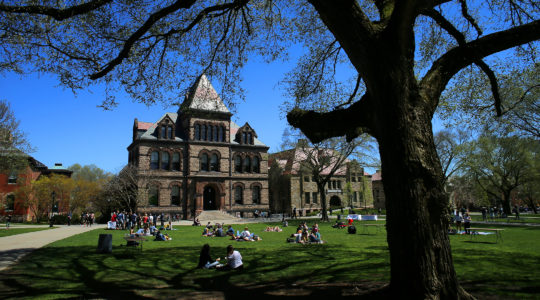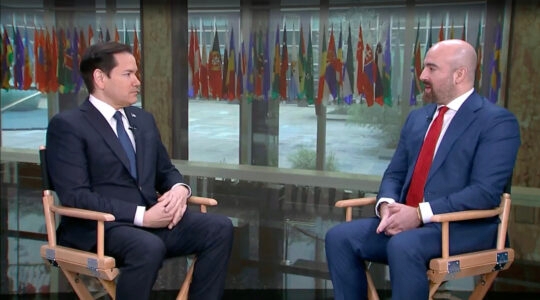LOS ANGELES (JTA) — A man arrives at an airport for a flight, and as he goes through security the agent asks some questions.
Did anyone help him pack his suitcase? What is the purpose of his trip? Is anyone accompanying him?
During the conversation, the agent enters answers and facial reactions into a computer pre-programmed with millions of pieces of information relating to the behavior of suspicious passengers.
Such man-and-machine collaborations, in this instance to detect terrorists, are not yet in place at airports. But they already are in use in fields ranging from medicine and genetics to Microsoft diagnostics and Google searches.
Underlying the remarkable advances in the partnership between humans and machines are research studies in artificial intelligence. AI is the subfield of computer science that aims to discover the fundamental building blocks of thought, creativity, imagination and language — those elements of the mind that make us intelligent.
Prof. Judea Pearl of the University of California, Los Angeles (UCLA) is among the internationally recognized pioneers in the field, and on March 29 he will add to his string of honors and awards the Harvey Prize in Science and Technology from the Technion-Israel Institute of Technology.
Pearl was selected for this recognition, which carries a $75,000 honorarium, for his “wide-ranging and keen research,” which has led to “his foundational work that has touched a multitude of spheres in modern life,” according to the citation.
Pearl, 75, born and raised in the Orthodox enclave of Bnei Brak, near Tel Aviv, leads a bifurcated life. As a professor emeritus, he teaches a class and guides doctoral students at UCLA. This, and his continuing research, takes up about half of his time.
The other half is devoted to the Daniel Pearl Foundation, headed and established by him and his wife Ruth following the 2002 kidnapping and murder by Pakistani extremists of their son Daniel, a reporter for the Wall Street Journal.
The foundation seeks to perpetuate Daniel’s ideals, and each year it organizes the Daniel Pearl Music Days around Daniel’s Oct. 10 birthday. This year, the event was celebrated with 2,091 separate concerts and performances in 84 countries, among them such unlikely venues as Saudi Arabia and Iran, according to the foundation.
The foundation also runs a fellowship that each year brings three working journalists from Muslim countries to the United States for five-month internships at U.S. newspapers, including the Wall Street Journal, The New York Times, and the Los Angeles Times, and for one week at the Jewish Journal of Los Angeles.
In his effort to draw some meaning from his son’s murder, the computer scientist-cum-philosopher has evolved into a forceful public speaker and newspaper columnist, including frequent commentaries in the Jewish Journal.
All the while, he’s continued to distinguish himself in the field of computer science. In 2008, when he received the Benjamin Franklin Medal in Computer and Cognitive Science from the Franklin Institute, Pearl was credited with research that “changed the face of computer science,” while his three books “are among the most influential works in shaping the theory and practice of knowledge-based systems.”
His combined work schedule has left Pearl little time to pursue his previous avocations as leader of a Hebrew-language choir, singer, guitarist and collector of rare, early editions of books on Judaica, philosophy, and history of science.
In his professional research, Pearl sees the interaction between humans and computers as a two-way street, in which humans infuse knowledge into machines, mainly in the form of natural language and graphs. The computer, in turn, sharpens human understanding, to the point where, Pearl says, “The only way to learn more about ourselves is by programming robots to emulate our behavior and, in this way, learn the architecture of the human mind.”
Pearl’s major contribution to the two-way dialogue between man and machine has been, first, in the area of uncertainty, a constant in every human endeavor, and later in causality, the relationship between cause and effect.
In our daily lives “we are prisoners of uncertainty,” Pearl says. He offers as an example a doctor’s examination of a patient. Using his knowledge and an array of sophisticated tools, the doctor will try to diagnose the patient’s symptoms and devise a treatment. However, even the best physician often can’t be certain he is prescribing the best possible cure.
The doctor’s computer can’t be certain, either, but it can review and combine thousands of pieces of information and offer the doctor a choice of the most promising treatment options.
Besides the ability to manipulate and recombine innumerable bits of information almost instantly, the robotic or computer helper can follow the resulting rules more consistently than a human, Pearl said.
But even so basic an example as a medical diagnosis involves tens of thousands of facts and rules, which must be programmed by a human and digested by the computer.
Pearl’s next step was to fuse, or break down, this mass of facts and formulas into what he labeled “Bayesian networks,” in honor of Thomas Bayes, an 18th century English mathematician. The networks mimic the neural activities of the human brain, constantly exchanging messages without benefit of a supervisor.
The research on uncertainty occupied Pearl for much of the first half of his career, and when it was finished in the late 1980s he turned his attention to the theory of causality to further advance the computer’s learning process.
Causality seems a fairly simple concept: We step on the gas pedal and the car accelerates. However, it’s easy to confuse this with the mere association between occurrences.
For instance, the word “malaria” is a contraction of the medieval Italian “mala” and “aria,” meaning “bad air,” because people who came down with the disease had often been near a swamp and breathed its foul air. Only later was it discovered that it was not the air that triggered the disease, but mosquitos that bred in the swamp.
One case in which a computer helped involved a lengthy study at Montreal’s McGill University that sought to prove that warm-ups before a game reduce the number and severity of sports injuries.
The researchers gathered statistics from numerous teams but also had to take into account such diverse factors as the types of warm-ups, attitudes of different coaches and players, ages of the team members and their previous injuries, pressures on the teams to win, fatigue from previous games, and so on.
For humans, it was impossible to juggle all these factors for hundreds of players, and the best that could be done was to establish some general associations between warm-ups and injuries.
Computers, however, could absorb and combine all these factors, judging how they affect each other, and come up with appropriate cause-and-effect relationships.
Pearl is now exploring ways of programming computers to reason introspectively and to take responsibility for their actions.
Such a project conjures up sci-fi scenarios of robots eventually outsmarting and subjugating their human inventors — a possibility to which Pearl says has devoted considerable thought.
While he believes that, at least in theory, “everything man can do, robots can do better,” he hopes that futuristic robots can also be indoctrinated with humanistic values and sensibilities.
The one exception to the robot’s perfectibility may be to instill and install a sense of humor.
“If we can make a computer come up with a funny joke, whose point generally rests on a failure of our anticipated expectation, we will have reached the pinnacle of success,” Pearl said.
JTA has documented Jewish history in real-time for over a century. Keep our journalism strong by joining us in supporting independent, award-winning reporting.





